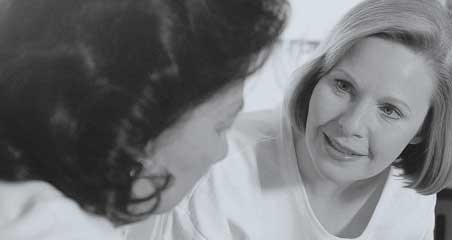Patient_guide_ad.qxd


AAN Guideline Summary for PATIENTS and THEIR FAMILIES
The American Academy of Neurology developed guidelines that summarize the best research on recognizing, diagnosing,and providing treatment options for people with Alzheimer's disease and their families. These guidelines will helpprovide the best care possible. You can use this summary version to learn more about:
• How you can recognize Alzheimer's disease
• How your doctor will diagnose Alzheimer's disease
• What treatment and care options are available today
• Where you can find more resources
How Can You Recognize Alzheimer's Disease?
What Are The Treatment And Care Options
Alzheimer's disease is different from normal aging. The
symptoms of Alzheimer's disease involve more than simple
Medications are available that help certain symptoms.
lapses in memory. People with Alzheimer's experience
These are called "cholinesterase inhibitors." They may
difficulties in communicating, learning, thinking, and
improve quality of life and cognitive functions including
reasoning that can have an impact on a person's work
memory, thought, and reasoning. Medication works most
and social and family life. Alzheimer's is a disease that
effectively for people who are mildly to moderately
destroys brain cells — which is not a normal part of aging.
affected by the disease. Therefore, the early recognitionand diagnosis of Alzheimer's disease is very important.
The 10 most common warning signs of Alzheimer's
However, medications do not reverse or change the
disease are included in this summary. If you or someone
progression of the disease.
you know has these symptoms, you should see a doctorfor a complete examination.
Research shows that Vitamin E is also an option to helpwith some symptoms of Alzheimer's disease. Vitamin E isan antioxidant, and it may aid in the breakdown of free
How Does A Doctor Diagnose Alzheimer's
radicals that may be damaging brain cells in individuals
with Alzheimer's disease. Selegiline is another antioxi-dant that may help with some symptoms of the disease.
Alzheimer's disease can be reliably diagnosed with a
complete examination that includes:
While a cure for Alzheimer's disease is not yet available,
• A complete medical and psychiatric history
research continues for new treatment options.
• A neurological exam
Changes in activities and medications improve behavior.
• Lab tests to rule out anemia, vitamin deficiencies, and
A person with Alzheimer's disease may display behavior
problems such as paranoia, suspiciousness, combativeness,
• A mental status exam to evaluate the person's thinking
or resistance to maintaining personal hygiene. These
behavioral problems can seem overwhelming to families
• Talking with family members or caregivers
and caregivers. Your physician may suggest various strategiesto assist in daily caregiving tasks including:
You can help your physician by being prepared for the
• Walking or other light exercise that helps reduce
appointment. Bring a list of current medications, a log
problem behaviors
of symptoms or behavior changes and a list of your
• Playing music, particularly during meals and bathing
questions or concerns. It is also helpful to provide an
• Providing a predictable routine for daily activities,
accurate history of the person's medical conditions and
including toileting
any previous treatment.

• Practicing various skills and positive reinforcement that
Where Can You Find More Resources?
increase independence
More information is available through your local
• Considering the medications available to help
Alzheimer's Association or your physician.
depression, agitation and psychosis
Find Local Patient Information
Caregiver educational programs can delay the time to
Alzheimer's Association
nursing home placement for the person with Alzheimer's.
Phone: 1-800-272-3900
Caregivers can find out more about educational programs
by contacting their local Alzheimer's Association.
Support groups are also available which help improve the
Find A Neurologist
well-being of the caregiver, as well as the person with
American Academy of Neurology
THE 10 WARNING SIGNS OF ALZHEIMER'S DISEASE
The Alzheimer's Association has developed a list of warning
6. Problems with abstract thinking. Balancing a checkbook
signs that include common symptoms of Alzheimer's disease.
can be challenging for many people, but for someone
Individuals who exhibit several of these symptoms should see
with Alzheimer's, recognizing numbers or performing
a physician for a complete examination.
basic calculation may be impossible.
1. Memory loss that affects job skills. It's normal to
7. Misplacing things. Everyone temporarily misplaces a wallet
occasionally forget an assignment, deadline, or colleague's
or keys from time to time. A person with Alzheimer's
name, but frequent forgetfulness or unexplainable
disease may put these and other items in inappropriate
confusion at home or in the workplace may signal that
places — such as an iron in the freezer or a wristwatch in
something's wrong.
the sugar bowl — and then not recall how they got there.
2. Difficulty performing familiar tasks. Busy people get
8. Changes in mood or behavior. Everyone experiences a
distracted from time to time. For example, you might leave
broad range of emotions — it's part of being human.
something on the stove too long or not remember to serve
People with Alzheimer's tend to exhibit more rapid mood
part of a meal. People with Alzheimer's might prepare a
swings for no apparent reason.
meal and not only forget to serve it but also forget they made it.
9. Changes in personality. People's personalities may change
somewhat as they age. But a person with Alzheimer's can
3. Problems with language. Everyone has trouble finding the
change dramatically, either suddenly or over a period of
right word sometimes, but a person with Alzheimer's disease
time. Someone who is generally easygoing may become
may forget simple words or substitute inappropriate words,
angry, suspicious, or fearful.
making his or her sentences difficult to understand.
10. Loss of initiative. It's normal to tire of housework, business
4. Disorientation to time and place. It's normal to momentarily
activities, or social obligations, but most people retain or
forget the day of the week or what you need from the store.
eventually regain their interest. The person with Alzheimer's
But people with Alzheimer's disease can become lost on
disease may remain uninterested and uninvolved in many
their own street, not knowing where they are, how they got
or all of his usual pursuits.
there, or how to get back home.
5. Poor or decreased judgment. Choosing not to bring a
Reprinted with permission from the Alzheimer's Association. For more
sweater or coat along on a chilly night is a common
information, call the Alzheimer's Association at 1-800-272-3900, email
mistake. A person with Alzheimer's, however, may dress
at [email protected] or visit the web site at www.alz.org
inappropriately in more noticeable ways, wearing a bathrobe to the store or several blouses on a hot day.
This is an evidence-based educational service of the American Academy of Neurology. It is designed to provide members with evidence-basedguideline recommendations to assist with decision-making in patient care. It is based on an assessment of current scientific and clinical information,and is not intended to exclude any reasonable alternative methodologies. The AAN recognizes that specific patient care decisions are the prerogativeof the patient and the physician caring for the patient, based on the circumstances involved. Physicians are encouraged to carefully review thefull AAN guidelines so they understand all recommendations associated with care of these patients.
1080 Montreal Avenue • St. Paul, MN 55116
Source: http://www.amazingdrz.com/Documents/AD_PatInfo.pdf
Microsoft word - coumarin - the real story update.doc
Coumarin: The Real Story (Updated Jan. 2008). Copyright © Tony Burfield 2006-2008 What is it? Coumarin (2H-1-benzopyran-2-one) CAS No 91-64-5, is a crystalline white solid when seen pure, with a hay-like, sweet aromatic creamy odour with certain nutty shadings, much used in synthetic form as a fragrance chemical for perfumes and for fragranced soaps and detergents. Coumarin has a widespread occurrence in natural products too (see separate section below), and is a representative of the lactones (where a lactone is an ester group integrated into a carbon ring system).
Untitled
15-Deoxy-Δ12,14-Prostaglandin J2 Upregulates the Expression of LPS-Induced IL-8/CXCL8 mRNA in Vascular Smooth Muscle Cel s from Spontaneously Hypertensive RatsJung Hae Kim and Hee Sun Kim*Department of Microbiology, College of Medicine, and Aging-associated Vascular Disease Research Center, Yeungnam University, Background: 15d-PGJ2 has been known to act as an anti-in-